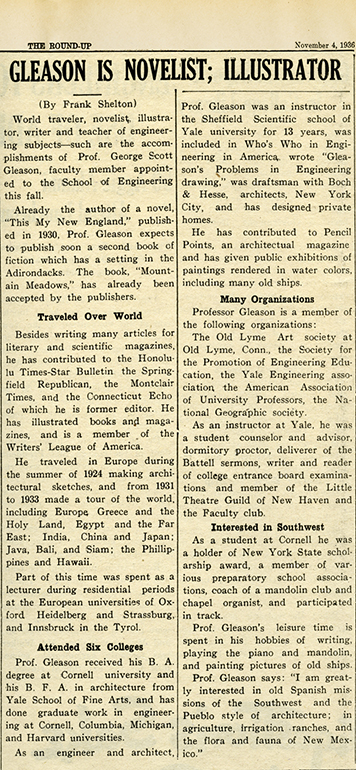Architectural Drawings


George Scott Gleason was a man of many interests as revealed in the 1936 ROUND-UP interview reproduced here. A lifelong poet and novelist, he taught French and German after receiving his A. B. from Cornell University. He pursued graduate studies in Engineering and Architecture at several eminent universities, received a Bachelor’s Degree in Fine Arts from Yale, and held various teaching assignments in engineering throughout the country. He came to New Mexico State University in 1936 as an instructor in the architecture curriculum but departed at the beginning of World War II. He subsequently served as a civilian instructor for the National Defense Training program and as an instructor in the Navy V-12 Training Program. Following the war, Gleason returned to the engineering faculty at Yale University. His faculty file from that institution indicates that he claimed no permanent address, having studied and taught throughout America and Europe his entire career. He was, however, a native of Glens Falls, New York, and was interred there after his death in 1969.
A Design for a Beach Club, John C. Kyriacopulos | Hobson-Huntsinger University Archives
The Five Orders, Garcia | Hobson-Huntsinger University Archives.
Sketch of a Girls' Dormitory for New Mexico State College, John C. Kyriacopulos | Hobson-Huntsinger University Archives
Architectural detail in Egyptian style | Hobson-Huntsinger University Archives
Railroad Station, E.A. Withers | Hobson-Huntsinger University Archives
Union Depot, Paradise, New Mexico; John C. Kyriacopulos | Hobson-Huntsinger University Archives
Design for bath houses and swimming pool, Prentiss D. White | Hobson-Huntsinger University Archives
Classic Temple, Prentiss White | Hobson-Huntsinger University Archives
Rustic Cabin in Woods, Mayer | Hobson-Huntsinger University Archives
Colonial Entrance, S. Bennett | Hobson-Huntsinger University Archives
Colonial Entrance, Thomas Marion Palmer | Hobson-Huntsinger University Archives
Design for a Pueblo House, E. Gardner | Hobson-Huntsinger University Archives
Three Studies of Entrances, A. Spivak | Hobson-Huntsinger University Archives
Refreshment Stand | Hobson-Huntsinger University Archives
La Estacion: Service Station-Trailer Camp-Commissary-Museum | Hobson-Huntsinger University Archives
Lincoln Highway Service Station | Hobson-Huntsinger University Archives
Suburban House, Bozeman | Hobson-Huntsinger University Archives
Tudor Style Cottage with floor plan, Neal Barr | Hobson-Huntsinger University Archives
Mansion with mountain backdrop, Withers | Hobson-Huntsinger University Archives
The Five Orders, Thomas Marion Palmer | Hobson-Huntsinger University Archives
Tudor Style Cottage with garden layout, Neal Barr | Hobson-Huntsinger University Archives
Patio steps, Spivak | Hobson-Huntsinger University Archives
Design for a Memorial Tower | Hobson-Huntsinger University Archives
Palladio, J.E. Bennett | Hobson-Huntsinger University Archives
Tuscan Order, Fitch | Hobson-Huntsinger University Archives
Architectural Detail: balcony on classical-style building, Neal Burr | Hobson-Huntsinger University Archives
Art Deco-style frieze detail; men and team of horses; E. Duarte | Hobson-Huntsinger University Archives
Plan for House | Hobson-Huntsinger University Archives
A Design for Service Station | Hobson-Huntsinger University Archives
A Bath House | Hobson-Huntsinger University Archives
A Bath House, Fitch | Hobson-Huntsinger University Archives
An Historical Museum: Front Elevation and Floor plan; J.C. Kyriacopulos | Hobson-Huntsinger University Archives
A Proposed State College Girls Dormitory, John Black | Hobson-Huntsinger University Archives
Garden Shelter | Hobson-Huntsinger University Archives
Design for a Suburban Home | Hobson-Huntsinger University Archives
Design for a House, J.E. Bennett | Hobson-Huntsinger University Archives
A Design for a Ranch House; Design by Woodward/Rendering by Alfred McLeskey | Hobson-Huntsinger University Archives
Drawing of house, fence, and trees | Hobson-Huntsinger University Archives
Drawing of Normandy-style home, Finch | Hobson-Huntsinger University Archives
Drawing of a rustic cottage, C.J. Hutt | Hobson-Huntsinger University Archives
Drawing of a Normandy-style cottage, Carl Freeman | Hobson-Huntsinger University Archives
A Design for a Suburban Cottage, John W. Collins | Hobson-Huntsinger University Archives

